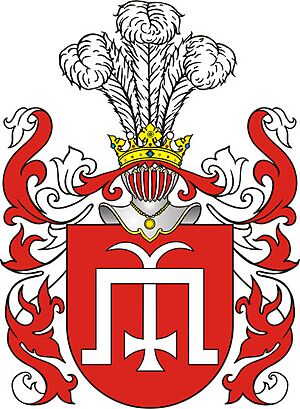Michael Glinski facts for kids
Michael Glinsky (born in the 1460s, died September 24, 1534) was an important noble from the Grand Duchy of Lithuania. His family had roots from the Tatars. He was also a teacher to his grand-nephew, Ivan the Terrible, who later became a famous Russian ruler. Michael Glinsky was born in a place called Turov.
As a young man, Glinsky worked for Emperor Maximilian I and became known for his military skills. Around 1498, he returned to Lithuania. He quickly gained a lot of power and wealth. This made many of the local nobles upset. In 1506, he led the Lithuanian army to victory in the Battle of Kletsk against the Crimean Khanate. Soon after, he was accused of plotting against Grand Duke Alexander Jagiellon. He lost all his wealth and started a rebellion against the new Grand Duke, Sigismund I.
His rebellion failed, and Glinsky went to the Grand Duchy of Moscow. There, he served Vasili III of Russia. In 1512, wars between Moscow and Lithuania started again. Glinsky helped Moscow capture Smolensk, an important trading city. However, he was not rewarded as he expected. He then planned to betray Vasili III, but his plan was found out. He was put in prison for 12 years.
He was set free in 1526 when his niece, Elena Glinskaya, married Vasili III. Before Vasili III died in 1533, he made Elena the ruler for his young sons, Ivan and Yuri. Elena did not like Glinsky's influence in state matters. She had him sent to prison again, where he died soon after.
Contents
Early Life and Western Courts
The Glinsky family believed they were related to Hungarian nobles and a famous leader named Emir Mamai. When Michael Glinsky was young, he was sent to serve Emperor Maximilian I. He fought in the emperor's army and showed great bravery. He was even given a special award called the Order of the Golden Fleece.
Glinsky also served Albrecht of Saxony during the Italian Wars. During this time, he changed his religion to Roman Catholicism. He traveled a lot in Austria, Italy, and Spain. He also studied medicine at the University of Bologna. Because of his travels, Glinsky knew many important nobles, including Emperor Maximilian I himself.
Rise to Power in Lithuania
In late 1498, Glinsky came back to Lithuania. He quickly became a close friend of Alexander Jagiellon, the Grand Duke of Lithuania. Right away, Glinsky became the Grand Duke's helper in Utena. By 1500, he was made the Court Marshal of Lithuania and joined the Lithuanian Council of Lords.
The next year, he was allowed to make money from trading wax and managing the coin factory in Vilnius. Glinsky knew a lot about Western Europe and spoke many languages. This meant he often worked as a foreign minister for the Grand Duke.
Glinsky's quick rise to power made other nobles jealous. His biggest rival was Jan Zabrzeziński, a powerful governor. In 1504, Grand Duke Alexander took land from Zabrzeziński's son-in-law because Glinsky asked him to. The next year, Zabrzeziński lost his titles and was removed from the Council of Lords. However, Zabrzeziński soon made up with Alexander and got his titles back.
In August 1506, Glinsky took over as commander of the Lithuanian army. The previous commander, Stanisław Kiszka, was sick. Glinsky led the Lithuanians to a big victory against the Crimean Khanate in the Battle of Kleck.
Glinsky's Rebellion
Glinski rebellion Grand Duke Alexander Jagiellon died in August 1506. His brother, Sigismund I, became the new ruler. Even before Alexander died, Zabrzeziński started spreading rumors. He said Glinsky planned to poison Alexander and even wanted to become ruler himself. These rumors worked. Glinsky lost his special rights and titles. His brother Ivan also lost his important position.
Since his trial was delayed, Glinsky and his family started a rebellion against Sigismund I. On February 7, 1508, Glinsky attacked Hrodna and killed Zabrzeziński. His men then tried to free a prisoner from Kaunas Castle, but they failed. Glinsky also planned to attack Vilnius, but he never did.
Glinsky said he was fighting for the rights of Eastern Orthodox people. He dreamed of creating a new state with its capital in Smolensk. His rebellion got some support from Orthodox nobles. It also became part of the war between Moscow and Lithuania (1507–1508). Even with help from the Grand Duchy of Moscow, Glinsky could not capture several cities like Minsk or Orsha. By 1508, Glinsky went to Moscow and promised to serve Vasili III of Russia.
Serving Moscow
In 1512, Moscow started fighting Lithuania again. They attacked Smolensk three times. Glinsky used his connections in Western Europe to bring skilled artillerymen. These experts were very important in helping Moscow capture Smolensk in July 1514.
Glinsky expected to become the governor of Smolensk for his help. But Vasili III chose someone else. Glinsky was very angry. He secretly started talking with Sigismund I. Glinsky offered to return to Lithuania and help them take back Smolensk if he was promised safety. However, the Russians found out about his plan, and Glinsky was arrested.
While in prison, waiting for his possible execution, he changed his religion back to Eastern Orthodoxy. This might have made Vasili less harsh, and Glinsky was pardoned.
Glinsky stayed in prison for 12 years. He was finally freed in 1526 when Vasili III married Glinsky's niece, Elena Glinskaya. Glinsky got back some of his wealth and power, serving Vasili III faithfully.
In 1533, Vasili III died from an infection. Before he passed away, Vasili made Elena the ruler for his young sons, Ivan and Yuri. Glinsky became part of the group that helped Elena rule. Soon, he became a political rival to Elena and her close friend. Elena spread rumors that Glinsky had poisoned Vasili, just as she claimed he had done to Alexander Jagiellon in Lithuania. In August 1534, he was sent to prison again, where he died on September 24.


